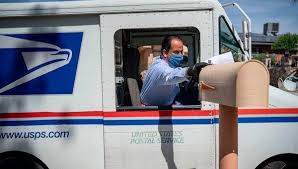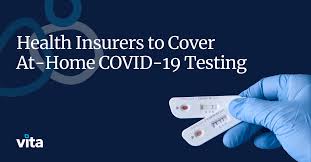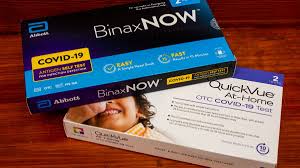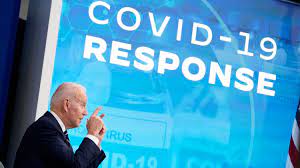|
By now most of you have heard that the Biden Administration is making one billion rapid at-home COVID tests available to the American public. This is in response to criticism that the government is not doing enough to combat the pandemic, particularly in the area of testing. There have been widespread shortages of at-home COVID tests and episodes of price gouging, so this seems to be a step in the right direction. How do you get the free test kits, and what should you know about their use? How to Order Free At-Home COVID Tests: The Federal Government’s new website to process orders is up and running. Each household is entitled to four free at-home rapid COVID tests. The site is easy to use. It took me less than five minutes to order my free tests. Simply log on to https://www.covidtests.gov/, and input your name and shipping address. The U.S. Postal Service will process and ship the tests to your home within 1-2 weeks. If you don’t have internet access you may order your free COVID tests at (800) 232-0233. The website is not able to handle orders from multiple households living at the same address, so there have been a few glitches. For those situations you may call the Postal Service help desk at (800) 275-8777, or file a service request at https://emailus.usps.com/s/the-postal-store-inquiry. The initial rollout of free at-home COVID tests is limited to four tests per household in order to promote broad access to the limited supply. But there are other ways to receive additional COVID tests at little or no cost to you. The test kits are available at some community health centers, rural clinics, and some federal testing sites. Private Health Insurers Mandated to Cover At-Home COVID Tests: As of January 15th private health insurers are required to fully reimburse for up to eight at-home rapid COVID tests per person, each month. The insurer will not be able to apply co-payments or deductibles, and there is no requirement for a doctor’s order or a clinical assessment. The government is incentivizing insurers to work with pharmacies and other outlets to provide the at-home COVID tests with no out-of-pocket costs to the consumer. For specifics on reimbursements and no-cost programs, reach out to your health insurance provider. Which At-Home COVID Test Will I Receive: There are thirteen at-home rapid antigen tests approved for use by the FDA to detect COVID. Only an approved antigen rapid test kit will be made available through the free program, but you do not have the ability to request a particular brand. Here are the currently approved at-home COVID antigen tests:
These tests are fairly easy to use and results are available in 15-20 minutes. Antigen tests detect the presence of a specific viral antigen, which implies current viral infection. The test requires you to swab each nostril for a specified period of time. The swab is then inserted into a buffer solution which then comes into contact with a test strip containing antibodies. A colored line appears on the test strip if it detects the antigen, indicating a positive test for the virus. Sensitivity of Rapid Antigen Tests: Based upon ongoing research studies, the FDA updated its testing guidance in December to indicate that the rapid antigen tests for COVID have reduced sensitivity to the Omicron variant. The PCR (Polymerase Chain Reaction) test remains the gold standard for the detection of all variants of the coronavirus. PCR tests are run in labs using sophisticated equipment, and the results may take several days to receive. Due to this delay, PCR is not a good screening tool for COVID. During a PCR test the genetic material from the virus is copied billions of times. This amplification allows even tiny amounts of genetic material from the virus to be detected. Therefore, it can detect the presence of the coronavirus even before the onset of symptoms, but also long after your symptoms subside and you are no longer contagious. For rapid antigen tests to be positive, there needs to be a high viral load. The viral load in most COVID patients is usually too low for the antigen test to detect until after the onset of symptoms, sometimes several days after. With the Omicron variant, people seem to be coming down with symptoms earlier in the infection, before viral loads are large enough to be detected by a rapid antigen test. This doesn’t mean that these tests don’t work, but it does mean that when and how the tests are used can impact results. If you test positive on a rapid antigen test, there is a high probability that you have COVID. But if you test negative, you may still have COVID. The two most recently approved rapid antigen tests show higher sensitivity to the detection of the Omicron variant than previous tests. These are the “Clinitest Rapid COVID-19 Antigen Self Test” by Siemens-Healthineers, and the “Standard Q COVID-19 Ag Home Test”, by SD Biosensor. When to Use At-Home Rapid Antigen Tests: These tests are most accurate when you are symptomatic for COVID. The CDC recommends using an at-home test if you have a fever, cough, sore throat, respiratory symptoms, muscle aches, or lose of taste or smell, https://www.cdc.gov/coronavirus/2019-ncov/testing/self-testing.html#anchor_1638718975230. Rapid COVID tests are also recommended for use five days after a potential COVID exposure, and as part of test-to-stay protocols in schools and workplaces. For best results I would wait 2-3 days after the onset of symptoms before testing with a rapid antigen test. A positive test result indicates that you likely have a current infection, and you should isolate and inform close contacts. A negative test result indicates that you may not be infected and may be at low risk of spreading disease to others, though it does not rule out an infection. If you plan to visit a vulnerable person in the near future, such as your grandmother, plan ahead. Minimize your social contacts for about a week and take a minimum of two tests prior to your visit. The final test should be within 24 hours of your visit. If you are symptomatic and get a negative test, repeat the test after 24-48 hours. This type of serial testing is often required for an accurate result, but it becomes problematic when you have a limited supply of tests available. Never rely on a single negative test, particularly if you have symptoms. It is best to self-isolate and have a PCR test performed, or assume that you are positive and take the necessary precautions. Other Considerations:
The government is discouraging the use of cloth face-masks. The CDC has updated its face-mask guidance to emphasize the better protection offered by N95 and KN95 masks. The Biden Administration is making available 400 million N95 masks free of charge to the American public. The free masks will be made available through select pharmacies and community health centers. You can find a list of locations offering the free masks at this link. The lack of adequate testing has hindered the United States’ response to the pandemic since day one. Most experts acknowledge that testing is an important step in mitigating virus spread. It appears as if the Biden Administration has finally determined that vaccines alone will not end this pandemic. The programs to provide free test kits and face masks to the American public are steps in the right direction. Now it’s time for every American to avail themselves of these tools and do their part to bring this pandemic to an end. If you enjoy reading this type of commentary please subscribe to my blog and tell a friend. You will receive an email notification when new blogs are posted. The email will come from the site’s email: armchairamerican1776 @gmail.com.
Thanks, Armchair American
0 Comments
|
AuthorThe Armchair American. Archives
November 2024
Categories
All
|















 RSS Feed
RSS Feed